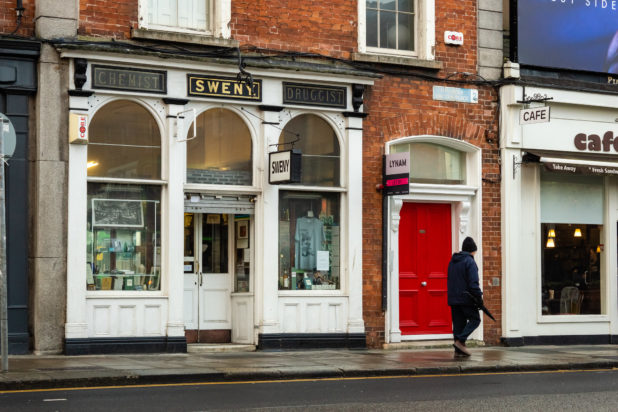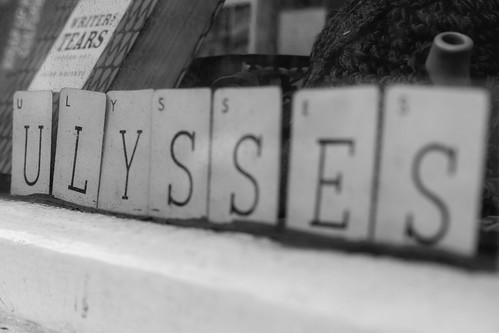James Joyce, Lemon Soap and the Philosopher’s Stone: The Story of Sweny’s Pharmacy – In this article, our new journalist Craig O’ Reilly talks about a little historical gem, Sweny’s Pharmacy
Had you passed Sweny’s pharmacy on Lombard street back in 2009, you might have been forgiven for doing so without interest. Those with an inclining eye, however, might have noted the rather unusual description of the premises as a “druggist”. Such terminology is rare to see nowadays in regards to pharmacies, suggesting the chemist is quite old.
Perhaps it was the same preoccupation with language that drew a young writer by the name of James Joyce through its slender door all the way back in 1904 (even then the building was over fifty years old). Joyce was an artist with an almost obsessive attention to detail. He grilled then pharmacist Frederick William Sweny extensively on various prescriptions, and details from this encounter would later find their way into one of the most seminal novels of the 20th century, Ulysses. Ever since that day, the pharmacy has had a curious history both factual and fictitious.
Leopold Bloom, the main protagonist of Joyce’s book, comes to Sweny’s to purchase ointments for his wife. While there he contemplates the history of alchemy and its effect on modern medicine in lurid detail:
“The chemist turned back page after page. Sandy shrivelled smell he seems to have. Shrunken skull. And old. Quest for the philosopher’s stone. The alchemists. Drugs age you after mental excitement. The first fellow that picked an herb to cure himself had a bit of pluck. Simples. Want to be careful. Enough stuff here to chloroform you.”
Ironically, that link between the small chemist and the search for the philosopher’s stone, would later have some significance for the fate of Sweny’s, though Joyce could not have known it at the time. In the book, the rejuvenating stone is symbolised by a bar of lemon soap Bloom steals while he is there, and he carries it with him in his pocket for the rest of the day.
It was one of his qualities as a writer that Joyce was able to find an almost mythical power in everyday, seemingly mundane life. What is most remarkable about this is he chose Dublin as the backdrop for his work. There have been many Irish-born writers such as Bram Stoker or Jonathan Swift who never felt the draw to describe the twisting streets of this ancient Viking city in their fiction, and it had been rather unjustly ignored in favour of other European cities like Paris and London.
It was Joyce, someone who felt he needed to exile himself from Dublin, who meticulously captured its people and places at a time of vast social and political change. Proof of this enduring legacy can be seen in the yearly gathering of Ulysses aficionados on Bloomsday who retrace the route Leopold Bloom took through the city.
As for Sweny’s chemist. It too seems to have taken on a new lease of life partly due to the regenerative powers of that same lemon soap. In 2009, economic factors caused it to cease trading as a pharmacy. The doors closed. Its long, quaint history appeared to have reached its end with little fanfare. What a surprise it must have been then, to photographers of the building, when people began to wander inside looking for the fabled “lemon soap”. The premises held a historic attraction for visitors since much of its former appearance had been “preserved through neglect”.
https://www.flickr.com/photos/fountainresourcegroup/49554096672/in/album-72157713163440141/
Since its inception in 1954, Bloomsday has only increased in popularity. People love to dress up as characters from the novel and visit the spots Joyce immortalised in his fiction. This has allowed an establishment like Sweny’s to stay open as a place of historical significance. Like Lazarus, it has come back from the dead so to speak.
Today it is run by a team of dedicated volunteers. Should you wish to visit, you can avail yourself of second-hand editions of Joyce’s books. There are also various reading groups which happen all through the week that focus on Ulysses and his other work. Many of these are discussing a particular section of the novel or reading passages aloud. This can be very helpful for those who may find the writing inaccessible; hearing it aloud can change the way we look at the text. While there, you may even decide to partake in some tea and biscuits. And of course, it need not be said, but you can purchase the lemon soap as well!











“Chemists rarely move” as Joyce has Mr Bloom observe. Sweny’s is still at No 1 Lincoln Place, looking down Westland Row towards Lombard Street.
Lombard Street, one-time home of Leopold and Molly Bloom, has in real life ben home to Nicholl’s undertakers (also mentioned in Ulysses) for generations.
And, in defence of Mr
And in defence of Mr Bloom’s goos name, character and posthumous reputation, I submit that he did not ‘steal’ the bar of sweet lemony-scented soap, but rather purchased it, by agreement with the vendor, to be paid for ‘on tick’ when he comes back for the lotion. But does he ever . . .?